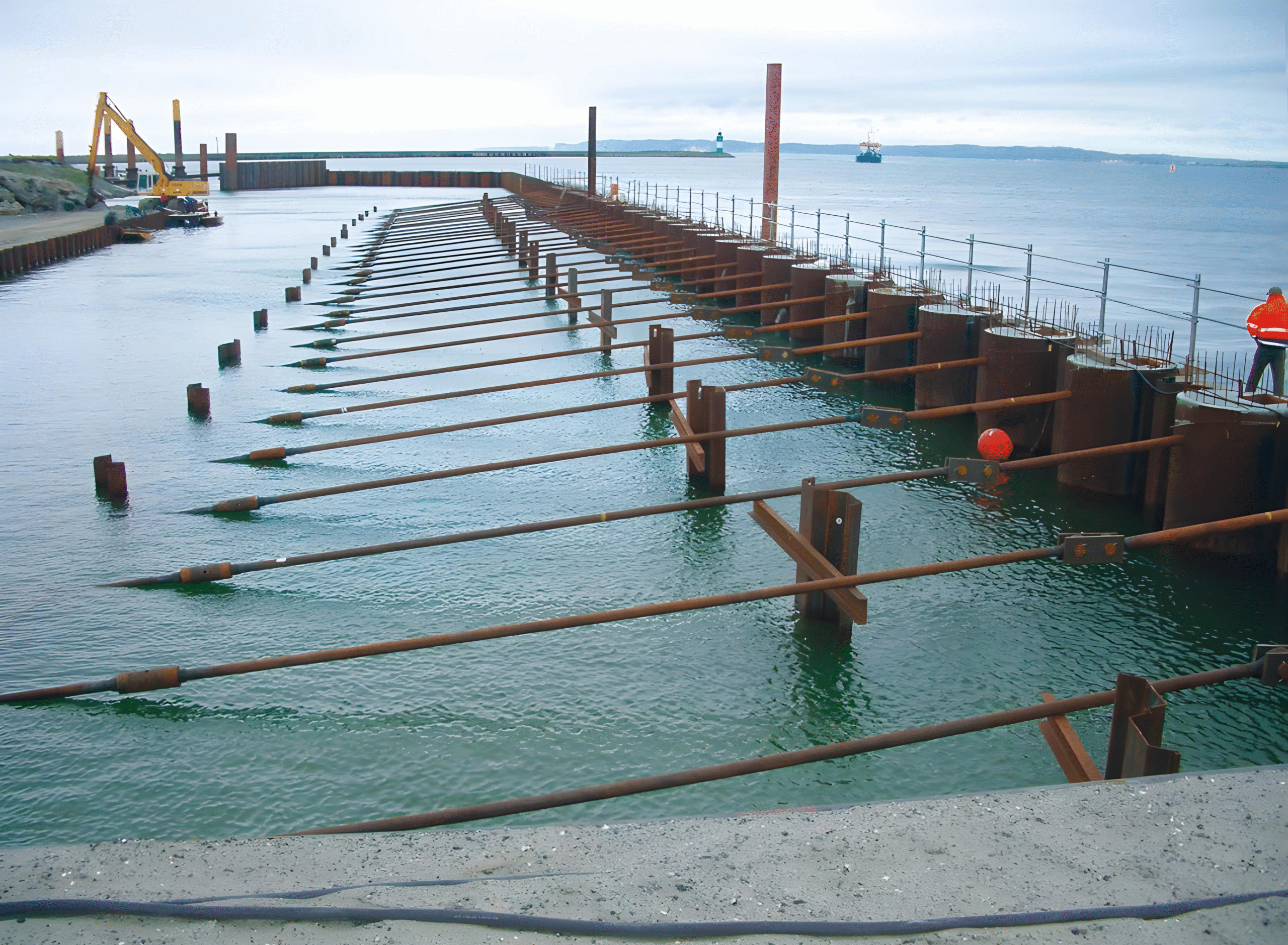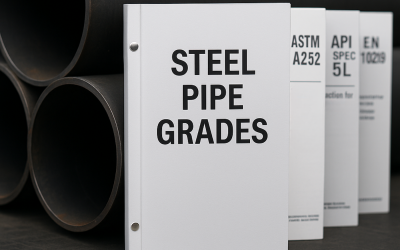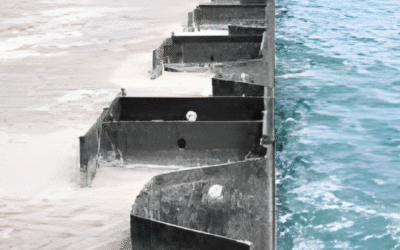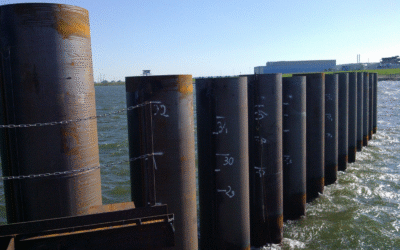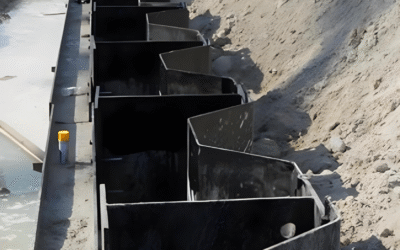Introduction: What Defines an Effective Anchor Tie Rod System?
An anchor tie rod system is the backbone of many retaining structures — from anchored quay walls to diaphragm walls and combi walls in ports, harbours, and other marine structures. Its main role is to safely transfer anchor forces from the front wall, sheet pile, or retaining structure to a secure anchorage in the surrounding foundation soils. But actual effectiveness means not just strength on day one — it means reliable long-term performance, durability against corrosion and fatigue, and a design that meets modern sustainability expectations.

System Components: Rods, Plates, Nuts, Couplers and Anchor Blocks
A robust anchor tie rod system includes multiple components, each contributing to the system’s secure anchorage and safe working load:
- Tie Rods: Typically manufactured from round steel bar, often using selected fine-grained or tempered steel grades for higher tensile strength and better fatigue resistance. Steel Tie Rods may have forged or threaded ends or use upset threads to connect to plates, nuts, or couplers. Articulated connections allow slight alignment adjustments in complex layouts.
- Wall Plates and Waling Beams: Distribute anchor forces evenly along the sheet pile wall or diaphragm wall. These help maintain geometry and reduce point loads that can weaken structural elements over time.
- Hex Nuts, Couplers and Upset Threads: Tie rods are often delivered in segments that must be joined onsite. High-capacity couplers and precision upset threads ensure that the full tensile capacity is maintained across connections. Quality system audited fabrication helps verify that these elements meet the above minimum properties.
- Anchor Blocks (Deadman): Buried concrete blocks or gravity structures installed at a calculated embedment depth in suitable soils. Proper backfill compaction provides passive resistance to resist pull-out. In some designs, a short buried sheet pile anchor wall may be used instead of a concrete block, developing passive resistance through the surrounding foundation soils just like a deadman.

Design Innovations: High-Strength Steel Grades and Adjustable Systems
Modern anchor tie rod systems benefit from several innovations:
- High-Strength, Certified Materials: Using advanced steel grades, such as S460 or S500, allows for slimmer rod diameters while achieving the same safe working load. Many systems are CE marked and produced under a certified quality system to ensure full traceability and compliance.
- Adjustable Tensioning: Hydraulic tensioning systems and articulated connections enable more precise onsite installation. Contractors can easily retension or adjust anchor tie rod forces, even after initial settlement.
- Enhanced Coatings: For marine structures and aggressive soils, multi-layer protection methods such as epoxy coatings, hot-dip galvanising, or the three-oil two-cloth method dramatically extend service life. These advanced coatings help reduce inspection intervals and support sustainability goals by lowering the lifecycle carbon impact.

Lifecycle Considerations: Fatigue, Corrosion and Inspection
Even a perfectly designed anchor tie rod system must withstand decades of loading cycles, exposure, and environmental stress:
Fatigue:
Tie rods in marine structures are exposed to repeated loads from wave action, berthing impacts, or vehicle surcharge. High-strength or tempered steel, combined with articulated connections and upset threads, can enhance fatigue life.
Corrosion, especially in marine structures:
Corrosion at tidal zones, buried ends, or threaded couplers is a common failure point. Durable coatings and optional cathodic protection help protect the whole system.
Optional Cathodic Protection: In addition to protective coatings, cathodic protection can be used to extend the lifespan of anchor tie rods in aggressive marine soils or tidal zones. This may involve installing sacrificial anodes or impressed current systems to reduce corrosion rates on exposed or buried sections. When used alongside regular inspections and maintenance, cathodic protection provides an extra layer of security for long-term durability.
Inspection Intervals:
A clear inspection regime — typically every 5–10 years — checks for residual tension, pitting, or misalignment. Many modern port owners also conduct tests after significant events, such as major storms.

Rehabilitation Techniques: Retensioning and Partial Replacement
Long-term performance means planned rehabilitation when needed:
Retensioning: Hydraulic jacks can be used to reapply tension if soil creep or settlement has reduced anchor forces below the defined safe working load.
Partial Replacement and Onsite Welding: Corroded segments can be cut out and replaced with new sections, joined with high-capacity couplers. On-site welding may be acceptable if it complies with the project’s audited quality system.
Protective Sleeves: New protective sleeves or wraps can be added to older rods for added corrosion resistance.

Case Study: Rehabilitation of an Ageing Anchored Sheet Pile Quay Wall
A recent project involved a 40-year-old anchored quay wall supporting heavy container loads. Routine inspection revealed corrosion and thread wear on some tie bars near the tidal zone. Engineers used non-destructive testing to confirm anchor forces and replaced affected segments with new round steel bar sections featuring forged ends and upgraded protective coatings. Retensioning and enhanced corrosion protection with modern coatings added decades of reliable service without disrupting port operations.
Sustainability Considerations: Longer Design Life, Lower Carbon
Modern anchor tie rod systems contribute to sustainability goals by focusing on:
- Longer Design Life: Better coatings, high-grade steel, and flexible rehabilitation options reduce the need for complete replacements.
- Low-Carbon Options: Environmentally friendlier coatings and more efficient supply chains can shorten lead times and lower overall emissions.
- Quality System Audited: Certifications help owners ensure materials meet or exceed required safe working loads and performance standards, supporting long-term durability.

Key Takeaways
- An effective anchor tie rod system depends on high-quality round steel bars, secure articulated connections, robust coatings, and ongoing monitoring.
- Innovations like upset threads, high-strength steel, and quality system–audited production help deliver reliable, long-term performance — even in demanding marine structures.
- Regular inspection, timely rehabilitation, and sustainability strategies extend service life and reduce the total carbon footprint of retaining structures and quay walls.
If you need design assistance, practical advice, or to source high-quality tie rods and anchor systems for your next project, our team is ready to help you build with confidence.
Related Products from Aema Steel
- Steel Tie Rod Systems
- Hot Rolled U Type Sheet Piles
- Hot Rolled Z Type Sheet Piles
- Steel Pipe Piles
- Welded H Piles
Contact us today to receive a tailored offer for your upcoming project.

